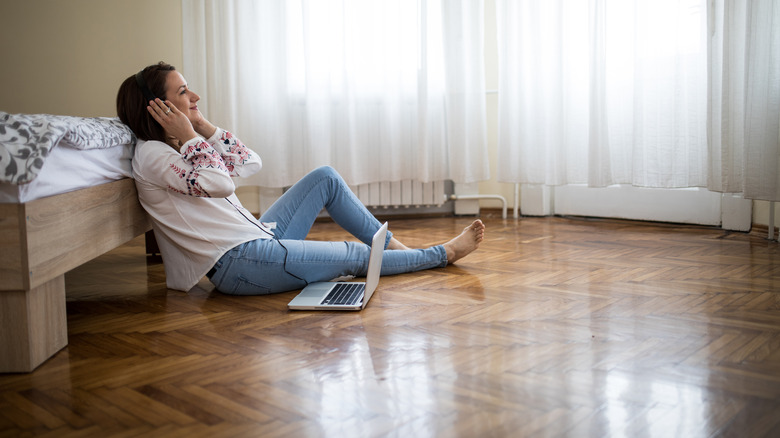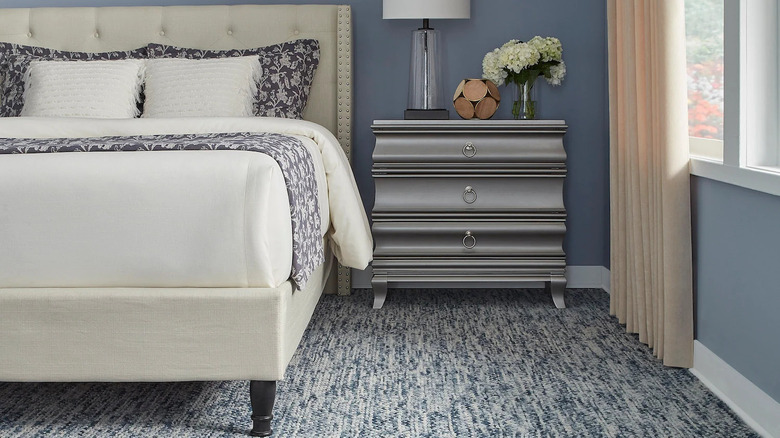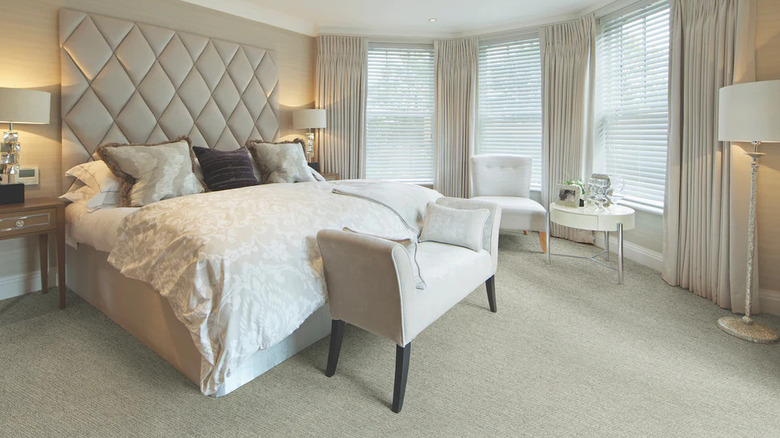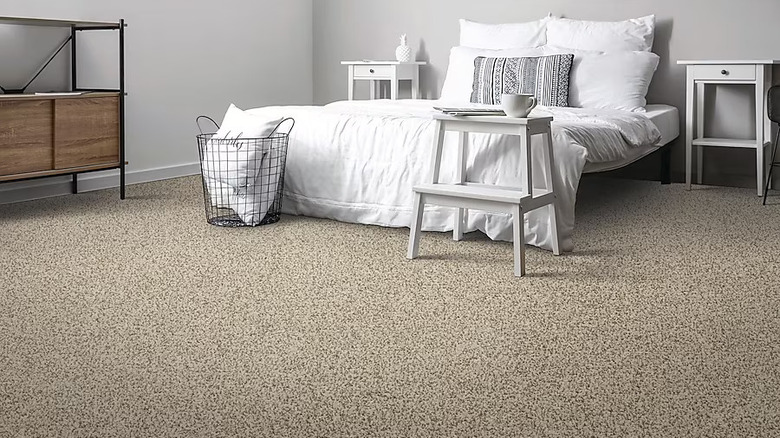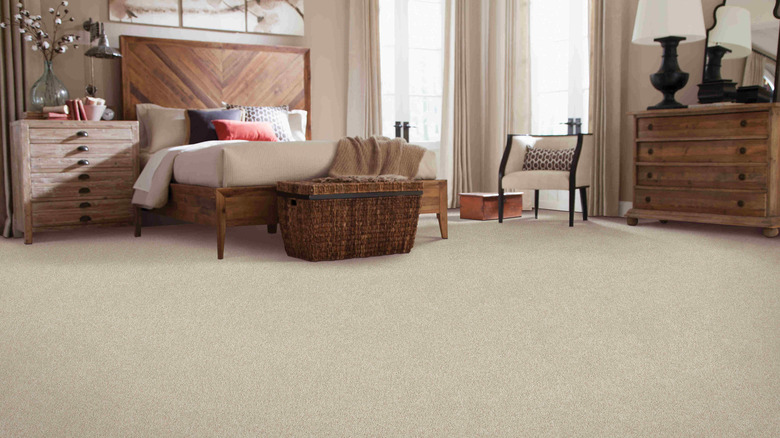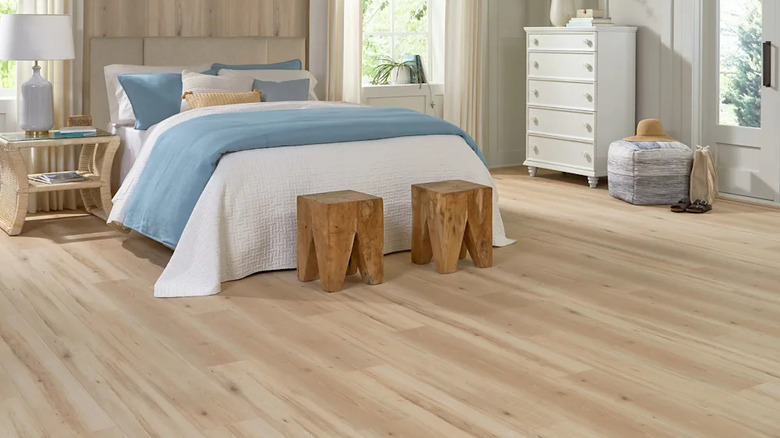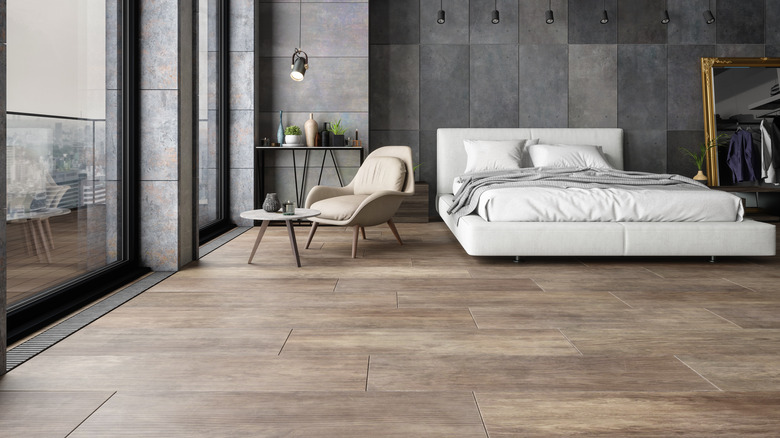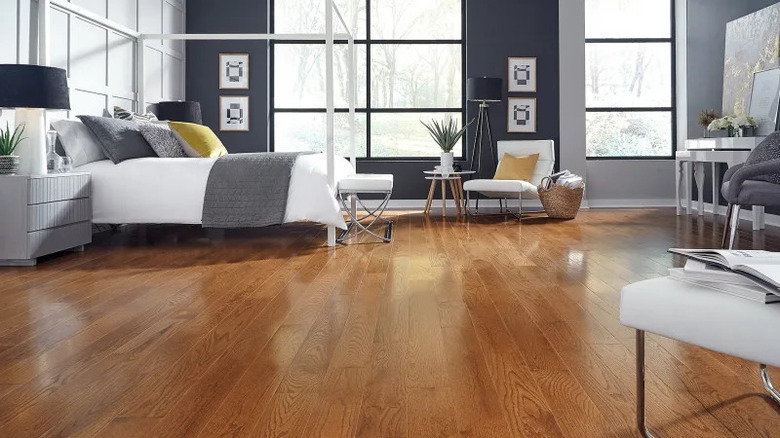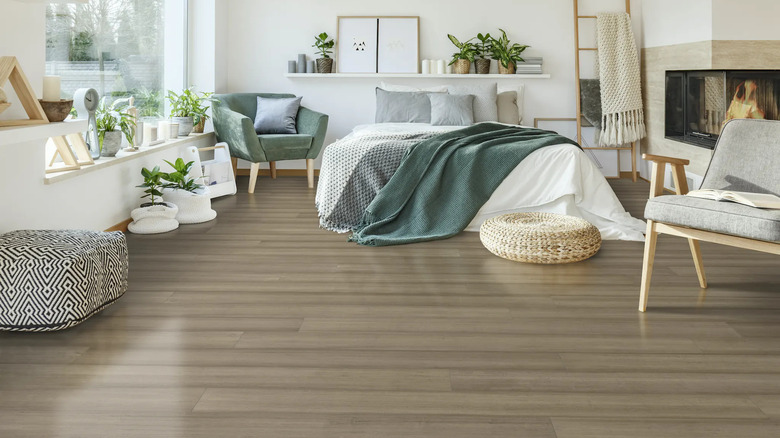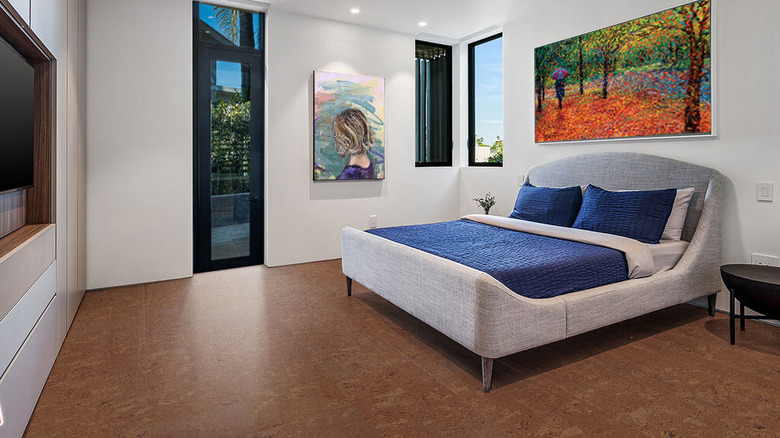The 9 Best Flooring Options For The Bedroom
Of all the rooms in your home, a bedroom should be prioritized as the one true sanctuary. In order to create the perfect place of respite, you need the right interior design combination to make the room your own. The flooring you choose greatly impacts the appearance and function of your bedroom, and you must ensure it complements your furniture and overall design style.
Plush carpets are cozy, warm, and muffle sounds to create a private nook. In contrast, traditional hardwood floors are homey, classic, and lend to a traditional atmosphere. Both soft and hard flooring types can befit a bedroom, but you must determine which best suits your own needs.
Below are nine of the most popular flooring types appropriate for bedrooms. They all range in styling possibilities, feel, upkeep, and longevity. Learn more about each type to determine which ones have the characteristics you're looking for to create a perfect sleeping space.
Wool carpeting keeps you warm in cold climates
The first carpets in human history were crafted with sheep's wool and goat hair. Thousands of years later, wool remains a popular choice for flooring. Weaving techniques have changed and advanced, but the base material — sheep's wool — proves to be a household favorite even in modern times. This material has humble origins, but is incredibly strong for natural fabric. It retains its shape and structure even after years of foot traffic.
This natural fabric easily absorbs dyes, meaning you can find this carpet in various colors and patterns for child and adult bedrooms alike. Dyes lock into the thick texture of wool, maintaining their vibrance over many years of everyday use and cleaning. Since the coils are so thick and sturdy, they hold liquid and dirt on the surface. This keeps the carpet from absorbing messes and staining, making it easy to clean as needed. The one drawback of wool is that it doesn't do very well with excessive direct sunlight, as the sun can cause its color to fade and affect the feel of the carpet.
In addition to its appearance and easy upkeep, woolen carpeting makes a great addition to bedrooms due to its cozy look and feel. The material insulates floors and adds a comfy vibe, which is especially great during colder seasons. The price for such a reliable and long-lasting carpet varies depending on pile height, colors, and additional treatments, so you can expect to pay between $5 to $26 per square foot.
Nylon carpeting is mildew, mold, and stain-resistant
Nylon carpeting is most commonly found in commercial buildings due to the practicality of its design. However, it also is a great fit for sensible homeowners looking for cozy and easily-maintained bedroom floors. It's a synthetic fabric, made from chemically processed polymers to form a unique plastic.
The fibers are tough and sturdy, and are usually low-pile to form a flat, but plush, surface. The simple texture makes it easy to pair with accent rugs and other decorative elements common in personalized bedrooms. You can install solid-colored nylon to create a modern design or layer it with bohemian-style jute and shag carpets to create a cozy, eclectic nook. Nylon carpets also come with various patterns and colors, accentuating loud and bold styles without needing any layering at all.
In addition to the styling possibilities, nylon carpeting is treated with stain resistance. Look for labels like "Scotchgard™ Carpet and Upholstery Protector" or "Teflon® Advanced Carpet Protector," which indicate manufacturers have had the carpet treated. Even with added protection, these carpets cost below $10 per square foot on average, making them feasible for most families.
Polyester blend carpeting is inexpensive and lasts long-term
Polyester blend carpeting is a go-to for most homeowners, known for its variety, reliability, and affordability. It's a synthetic fabric made from plastic, just like nylon, which gives it many of the same benefits. The main difference between the two is that polyester prioritizes softness over durability.
The "fluffiness" level of polyester is higher with high-pile fibers, but can also be made firmer with low-pile. In either case, it comes in an assortment of colors and patterns for mundane and playful bedrooms alike. Both Lowe's and Home Depot have over 200 polyester carpet options available. That number doesn't even include the different color options you can choose from.
The only downside of polyester carpeting is that it isn't as durable as nylon or as long-lasting as wool. However, bedrooms are typically low-risk, low-traffic areas, meaning you might not need the most resilient carpet type for this room. Polyester's manufacturing process makes it resistant to allergens, mold, mildew, and stains. Keeping it clean requires just vacuuming and wiping up spills, and therefore it's a low-upkeep flooring option for private quarters. Prices start at less than $1 per square foot, easily making this the most affordable bedroom flooring option.
Triexta carpeting is new and contains fewer volatile organic compounds (VOCs)
You may have come across Triexta or SmartStrand carpeting during your search for the right bedroom floor. This is an alternative polyester type that is relatively new to the carpeting industry and is slowly gaining traction due to its many pros. The Triexta and SmartStrand fibers are manufactured with nylon's strength and polyester's resistance to allergens, mold, mildew, and stains.
The companies behind Triexta and SmartStrand fabrics have a lot of faith in their products, often offering warranties as long as 25 years, or even a lifetime. They're also a great choice for people who want to ensure they're sleeping in a safe space. Unlike other carpeting materials, which are made with petroleum, this innovative polyester is made from corn glucose. The manufacturing process involves fewer chemicals. Therefore, this carpet releases fewer volatile organic compounds (VOCs) into your bedroom. Many knowledgeable homeowners want to avoid putting such materials in rooms, especially if other family members or housemates are sensitive to these reactions.
Laminate wood flooring is an affordable, classic favorite
If you have your heart set on hardwood floors in your bedroom but cannot afford the high price of authentic wood, laminate is a far more reasonable alternative. It is a plastic-based product with three layers: a particleboard base, a wood-like top, and a transparent coating. The particleboard bottom makes the laminate softer underfoot, while the top board and its protective covering give it the strong wooden appearance.
Due to its physical similarities to genuine hardwood, this material is a great fit for bedrooms. You can choose between glossy and matte looks, befitting rustic, traditional, and modern designs. The slabs are lightweight, which makes them a potential DIY project if you have time to install the floors yourself.
Although the top coat provides some protection, don't expect this material to hold up as long as higher-priced floors. It's great for bedrooms with minimal foot traffic, as there won't be as much wear and tear. Bedrooms usually don't have plumbing fixtures, and families may disallow food or drinks in these areas, minimizing the risk of water spills and stain damage. This flooring type holds up well for only $1 to $4 per square foot.
Luxury vinyl is affordable, durable, and stain-resistant
Luxury vinyl planks are a step up from laminate wood because of their more complex nature. Each plank is made of five pieces laid over one another: a sunlight-resistant topcoat, a faux stone or wood top, a plastic layer, a waterproof core, and a foam base. Each layer plays a role in giving luxury vinyl its elegant appearance, which overlays a comfortable foundation.
Luxury vinyl is not limited to a wood-like appearance and can be painted and shaped to imitate any material you desire. This naturally makes these planks suited for tranquil, minimalistic bedrooms and bold, maximalist living spaces. Their versatile appearance has other benefits, such as sun, water, stain, and scratch-resistant coatings.
With these characteristics, vinyl is an optimal choice for bedrooms for all ages, from babies to adults. The faux material is relatively soft for children to play on, and it won't stain when encountering spilled snacks and drinks. These pros are ideal for families, roommates, and any other combination of house members, all for the reasonable cost of $2 to $5 dollars per square foot.
Traditional hardwood flooring is long-lasting and beautiful
Authentic hardwood flooring has withstood the test of time, being commonplace in homes for hundreds of years. Since those early days, this traditional material has been treated and sealed with new methods that make genuine wood ideal for most rooms in all climates. When you choose a hardwood for your floor, look for species graded above a 1250 rating on the Janka Hardness Scale. These include trees like ash, beech, birch, maple, oak, and rosewood, which are durable and long-lasting with the right upkeep.
Hardwood is an excellent choice for the bedroom because its attractive and organic appearance meshes well with all interior design styles. Wood comes in many hues, and you can stain it to be light, dark, neutral-toned, or more eccentric shades. Although it isn't the softest material out there, it's easy to add accent or area rugs to soften a bedroom with this flooring type.
With the right sealant and protective coating, hardwood is scratch and stain-resistant as long as you keep up with routine sweeping and promptly wipe up spills. If you're on a budget, the main downside of this flooring is the cost. Genuine hardwood costs between $18 to $24 per square foot. It's typically too heavy and valuable for most people to DIY, meaning you'll need to hire a professional installer.
Bamboo flooring is good for the allergy-prone
Many retailers list bamboo flooring alongside their hardwood options, but these types have their differences. For starters, bamboo flooring comes from grass, not wood. Despite the connotation of being grass, it is surprisingly durable and rates at 1380 on the Janka Hardness Scale, meaning it's just as tough as many hardwood species.
Bamboo shares many aesthetic characteristics with hardwood, again making it a great feature for any style bedroom. You can find stains ranging from browns to grays to blacks, which can be reapplied to horizontal and vertical bamboo planks to preserve the look over time. The only bamboo look that can't be refinished is strand-woven flooring. The shredded and pressed grass material in this style is incredibly durable and has double the Janka Hardness Scale rating, so you won't be able to refurbish it — but you also won't need to for up to 20 years.
In addition to its appearance and durability, bamboo's surface is allergy-friendly. It's easy to sweep and remove dust and pollen. If you or a family member has trouble sleeping during certain seasons, bamboo flooring could help clear up the small particles triggering these irritating reactions. At around $5 per square foot, it's about a quarter of the price of hardwood, making it more affordable for those restyling their bedroom on a stricter budget.
Cork flooring has the beauty of hardwood and the softness of carpet
Cork flooring is the most unconventional flooring on this list, but it deserves consideration due to its unique nature. This material comes from cork trees, but possesses the qualities of both wood and carpet flooring. During production, the harvested cork is mixed with air to create a soft, almost plush wood-like material. It comes in many of the same shades of traditional hardwood and can be stained to be darker, lighter, or more vibrant in color. You can purchase it pre-painted or stained in a specific color, or do it yourself with prep work.
In addition to its versatile color options, cork has a spongy feel compared to most wood, vinyl, and laminate floors. The rubbery consistency effectively muffles noise and cushions falls — which is why we draw the parallel to carpet — and also why it's a great fit for a child's bedroom. This material's smooth surface repels water and allergens and deters insects, making it easy to keep clean. The only concern is that it is not a very durable option. Sliding furniture around or digging sharp heels into the ground can damage the cork and leave irreparable damage. Luckily, this material is often sold in tile form, and if you do cause any scratches or nicks, you can easily replace individual tiles as needed. Seeing as cork costs around $3 to $9 per square foot, repairs won't be too expensive when you're replacing small portions at a time.

